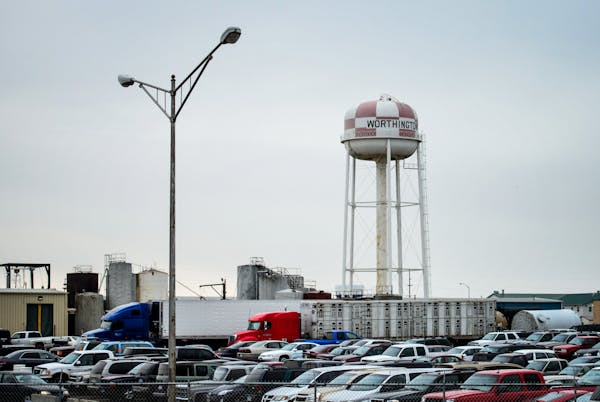By Sunday, those fears were more than realized when the number of confirmed COVID-19 cases soared to 69 in Nobles County — a sharp increase from the two cases they had just days ago. And the numbers are expected to continue climbing.
Minnesota Department of Health (MDH) officials have interviewed 32 people who have tested positive in Nobles County and learned that 26 work at the JBS pork plant in Worthington and five are relatives of those workers.
Staff from the Department of Labor and Industry (OSHA) and MDH plan to be at JBS on Monday to observe measures the company is taking to stem the spread of the coronavirus.
On Friday, union officials at JBS, the city's largest employer with more than 2,000 workers, reported that 19 employees had tested positive for COVID-19. The emergence of the cluster came just days after Smithfield Foods, a pork plant an hour west in Sioux Falls, closed because of a surge in infections. By Friday, more than 700 workers there had tested positive for COVID-19.
The spike in cases at the Worthington plant, so soon after the explosion of cases in Sioux Falls, have many residents across southwestern Minnesota increasingly uneasy about what could erupt here.
"It's hitting home," said Oberloh, a City Council member and former mayor. "People will be fearful and more worried.
"We're a packinghouse town. We have 2,000 people who work shoulder to shoulder."
Vulnerable and scared
There's a symbiotic relationship for those living along the Minnesota-South Dakota border. They live in one state but often cross the border to work and shop in the other. If they're infected, they bring the virus with them.
For that reason, those living in the southwest corner of Minnesota girded themselves for an influx of COVID-19 cases, knowing their neighbors to the west weren't under the same strict stay-at-home measures.
South Dakota is one of the few states where the governor hasn't issued a blanket stay-at-home order to stem the spread of the coronavirus. Instead, residents are instructed to follow social-distancing guidelines, including keeping crowds to 10 or fewer people.
Many bars and restaurants in Sioux Falls have either shut down or limited service to curbside pickup. But others are open, sometimes drawing cooped-up Minnesotans.
"There are some in our community who think the stay-at-home order doesn't affect them and go across the border to take in the nightlife," said Pat Baustian, mayor of Luverne, Minn., which sits close to the South Dakota border. "Shame on them."
As Sioux Falls becomes a COVID-19 hot bed, more Minnesotans are reconsidering shopping trips across the border.
Myron Koets and his wife are hunkered down in Pipestone, Minn., a city of about 4,000 people less than an hour's drive northeast of Sioux Falls.
The 73-year-old Vietnam veteran has diabetes and high blood pressure and his 76-year-old wife has asthma and is a cancer survivor, putting them in the high-risk group for COVID-19, the respiratory disease caused by the new coronavirus.
"We both know if we get this, our chances of survival aren't probably real good," he said.
As Pipestone's mayor, Koets will urge residents to double-down on the precautions health care officials have preached for weeks regarding social distancing and washing hands.
An outbreak in his town of about 4,000 people would overwhelm the city's 15-bed hospital, which has two ventilators.
"Sioux Falls is our backup system," he said, "so if hospitals there get flooded with patients, we'll have to look in different directions."
'We're all vulnerable'
Back in Worthington, city officials hope the town of about 13,000 residents does better at curbing the virus than their South Dakota neighbors.
"People need to take this seriously," Oberloh said. "We need to stop the spread."
This is not an immigrant or meatpacking problem, he and other city officials stressed. The virus could just as easily be transmitted on a factory floor, a crowded office or in the grocery store.
"We're all vulnerable," said Steve Robinson, Worthington city administrator.
Still, as the case counts spiked over the weekend, residents grew more worried.
"I'm scared," said Sonia Castro after ringing up the bakery orders for several customers at the Panaderia Mi Tierra on Saturday afternoon.
Castro wore a face mask and stood behind a newly installed plexiglass shield at the counter while waiting on customers. She spent much of her day disinfecting it and other surfaces in the bakery.
As Castro tended to customers, Fernanda Duque browsed, her mouth and nose covered by the red bandanna she sewed into a face mask. An employee at JBS, she, too, worries about the rise in the number of COVID-19 cases.
Despite her fears, she has to keep working production at the pork plant.
"If I don't go, how will I pay the bills?" said the 33-year-old mother of four who lives with her husband and sister.
At work, employees must wear masks, constantly douse their hands with sanitizer, have their temperatures taken and wear boots that are disinfected, Duque said.
"I feel they're doing the best they can to keep us safe," she said.
Fear of the unknown
As Worthington residents ran weekend errands, reminders of COVID-19 were everywhere.
Retailers have taped X's on the floor at checkout lanes, marking the appropriate social distance for customers. Shoppers at the Hy-Vee followed newly added one-way arrows on the floor to reduce congestion in the aisles.
The city-owned liquor store only allows 10 customers inside at a time. And Worthington's 19 parks are closed and the basketball hoops have been taken down.
At the Sanford Health Worthington Clinic, a centralized drive-through testing site popped up Friday on the parking lot. It had been in the works even before the spike in confirmed cases, said Sanford Health spokesman Shawn Neisteadt.
And all across town, people donned face masks — shoppers, the guy filling up his gas tank, children playing in a backyard and neighbors chatting from porch to front sidewalk.
One of the few, mostly mask-free spots Saturday afternoon was a trail along Lake Okabena, where runners, bikers and walkers made their way against a strong west wind driving across the lake.
A mother of two pushed her 11-month-old daughter in a stroller while her husband chased after their 2-year-old son. "We needed to get out of the house," she said, asking that her name not be used.
Still, for those who understand the gravity of the virus, there's great anxiety.
The woman, who teaches sixth-grade English learners in Worthington teared up when talking about her students.
"They want to make sure their families are safe," she said.
Mary Lynn Smith • 612-673-4788
Project will light up Rock Island Swing Bridge
Brooklyn Park community development director departs for Bloomington

Want Timberwolves playoff tickets? So does everyone else

